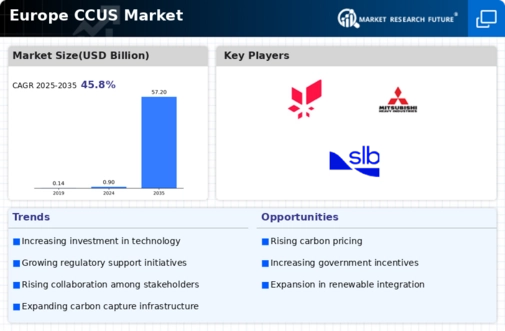Market Share
EUROPE CCUS Market Share Analysis
The Europe CCUS (Carbon Capture, Utilization, and Storage) market is currently experiencing dynamic trends that reflect the region's commitment to mitigating climate change and achieving carbon neutrality. One prominent trend is the increasing adoption of CCUS technologies across various industries. Governments and businesses alike are recognizing the pivotal role that carbon capture plays in reducing greenhouse gas emissions.
Several European countries are actively investing in CCUS infrastructure and projects to achieve their climate targets. The European Union's ambitious Green Deal, aiming for net-zero emissions by 2050, has been a driving force behind the surge in CCUS initiatives. As a result, the market is witnessing a notable uptick in funding for research and development, as well as the implementation of large-scale CCUS projects.
In recent years, there has been a growing emphasis on the utilization aspect of CCUS. Beyond merely capturing and storing carbon dioxide, there is a push towards finding innovative ways to utilize this captured carbon. Industries are exploring avenues such as carbon utilization in the production of fuels, chemicals, and materials. This trend aligns with the circular economy concept, where waste products are repurposed, contributing to a more sustainable and resource-efficient future.
Collaboration between public and private sectors is another key trend in the Europe CCUS market. Governments are incentivizing businesses to invest in CCUS technologies through subsidies, tax breaks, and other financial incentives. This collaborative approach is essential for overcoming the financial barriers associated with CCUS projects, making them more economically viable for implementation.
Furthermore, there is a noticeable shift towards regional cooperation in the development and deployment of CCUS infrastructure. European countries are recognizing the shared challenges and opportunities in achieving carbon neutrality, leading to collaborative efforts to create interconnected CCUS networks. This approach enhances the efficiency of carbon capture and storage, facilitating the movement of captured carbon across borders for storage or utilization.
The energy sector plays a pivotal role in the Europe CCUS market trends. As the region transitions towards cleaner energy sources, there is an increased focus on decarbonizing existing fossil fuel-based energy production. CCUS is viewed as a crucial tool in this transition, allowing for the continued use of fossil fuels while minimizing their environmental impact. The retrofitting of existing power plants with carbon capture technology is becoming a prevalent practice, ensuring a more sustainable energy mix.
Public awareness and acceptance of CCUS technologies are also on the rise. As the urgency of addressing climate change becomes more apparent, there is a growing understanding among the general population about the role of CCUS in mitigating carbon emissions. This increased awareness is influencing both public and private sectors to allocate resources and efforts towards CCUS projects.
However, challenges persist in the Europe CCUS market. One notable obstacle is the need for a robust regulatory framework that addresses issues related to liability, storage, and transportation of captured carbon. Clear and standardized regulations are essential for fostering a conducive environment for CCUS investments and operations.
In conclusion, the Europe CCUS market is characterized by dynamic and positive trends driven by environmental imperatives, government policies, and technological advancements. The increasing adoption of CCUS technologies, emphasis on carbon utilization, collaborative efforts, energy sector transformations, and growing public awareness collectively contribute to a promising future for carbon capture, utilization, and storage in Europe. As the region continues to prioritize sustainability and climate action, the CCUS market is poised for further growth and innovation in the coming years.






Leave a Comment